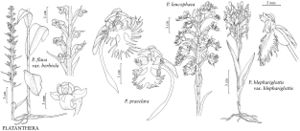Difference between revisions of "Platanthera flava var. herbiola"
Native Orchids U.S. & Canada, 214. 1975.
FNA>Volume Importer |
FNA>Volume Importer |
||
| Line 30: | Line 30: | ||
|distribution=N.B.;N.S.;Ont.;Que.;Ark.;Conn.;Del.;Ill.;Ind.;Iowa;Ky.;Maine;Md.;Mass.;Mich.;Minn.;Mo.;N.H.;N.J.;N.Y.;N.C.;Ohio;Pa.;R.I.;Tex.;Vt.;Va.;W.Va.;Wis. | |distribution=N.B.;N.S.;Ont.;Que.;Ark.;Conn.;Del.;Ill.;Ind.;Iowa;Ky.;Maine;Md.;Mass.;Mich.;Minn.;Mo.;N.H.;N.J.;N.Y.;N.C.;Ohio;Pa.;R.I.;Tex.;Vt.;Va.;W.Va.;Wis. | ||
|discussion=<p>Tuberoids and the over-wintering bud typically form at a marked distance from the parent shoot, resulting in clonal colonies dominated by sterile plants.</p><!-- | |discussion=<p>Tuberoids and the over-wintering bud typically form at a marked distance from the parent shoot, resulting in clonal colonies dominated by sterile plants.</p><!-- | ||
| − | --><p>The southern Platanthera flava var. flava and the northern var. herbiola are very distinct in their extreme forms, but they seem to intergrade, at least in the herbarium. They are usually as readily distinguished by plant habit as by lip shape. The slender, laxly flowered habit of the former is compounded by usually short floral bracts, whereas in the latter bracts are typically longer than the flowers and often exceed them, adding to the congested and broader aspect of the inflorescence. Further complicating determination are a few specimens from the region from the southern tip of Lake Michigan south and southwestward. Those have markedly triangular lips with prominent triangular auricles or basal lobes. These stout but rather laxly flowered plants seem to occupy mesic wooded slopes and may constitute a distinct taxon; comparisons should be made with similar Asiatic species.</p> | + | --><p>The southern <i>Platanthera flava </i>var.<i> flava</i> and the northern <i></i>var.<i> herbiola</i> are very distinct in their extreme forms, but they seem to intergrade, at least in the herbarium. They are usually as readily distinguished by plant habit as by lip shape. The slender, laxly flowered habit of the former is compounded by usually short floral bracts, whereas in the latter bracts are typically longer than the flowers and often exceed them, adding to the congested and broader aspect of the inflorescence. Further complicating determination are a few specimens from the region from the southern tip of Lake Michigan south and southwestward. Those have markedly triangular lips with prominent triangular auricles or basal lobes. These stout but rather laxly flowered plants seem to occupy mesic wooded slopes and may constitute a distinct taxon; comparisons should be made with similar Asiatic species.</p> |
|tables= | |tables= | ||
|references= | |references= | ||
| Line 54: | Line 54: | ||
|publication year=1975 | |publication year=1975 | ||
|special status= | |special status= | ||
| − | |source xml=https://jpend@bitbucket.org/aafc-mbb/fna-data-curation.git/src/ | + | |source xml=https://jpend@bitbucket.org/aafc-mbb/fna-data-curation.git/src/8f726806613d60c220dc4493de13607dd3150896/coarse_grained_fna_xml/V26/V26_1150.xml |
|subfamily=Orchidaceae subfam. Orchidoideae | |subfamily=Orchidaceae subfam. Orchidoideae | ||
|tribe=Orchidaceae tribe Orchideae | |tribe=Orchidaceae tribe Orchideae | ||
Revision as of 16:40, 18 September 2019
Inflorescences rather dense, stout (in part from floral bracts usually long, often greatly exceeding flowers); lip (excluding auricles) oblong, obtuse or rarely emarginate, rarely triangular and acute. 2n = 42.
Phenology: Flowering May–Aug.
Habitat: Alluvial forests, riparian thickets, wet meadows, wet prairies, seeps, salt marshes
Elevation: 0–900 m
Distribution

N.B., N.S., Ont., Que., Ark., Conn., Del., Ill., Ind., Iowa, Ky., Maine, Md., Mass., Mich., Minn., Mo., N.H., N.J., N.Y., N.C., Ohio, Pa., R.I., Tex., Vt., Va., W.Va., Wis.
Discussion
Tuberoids and the over-wintering bud typically form at a marked distance from the parent shoot, resulting in clonal colonies dominated by sterile plants.
The southern Platanthera flava var. flava and the northern var. herbiola are very distinct in their extreme forms, but they seem to intergrade, at least in the herbarium. They are usually as readily distinguished by plant habit as by lip shape. The slender, laxly flowered habit of the former is compounded by usually short floral bracts, whereas in the latter bracts are typically longer than the flowers and often exceed them, adding to the congested and broader aspect of the inflorescence. Further complicating determination are a few specimens from the region from the southern tip of Lake Michigan south and southwestward. Those have markedly triangular lips with prominent triangular auricles or basal lobes. These stout but rather laxly flowered plants seem to occupy mesic wooded slopes and may constitute a distinct taxon; comparisons should be made with similar Asiatic species.
Selected References
None.
